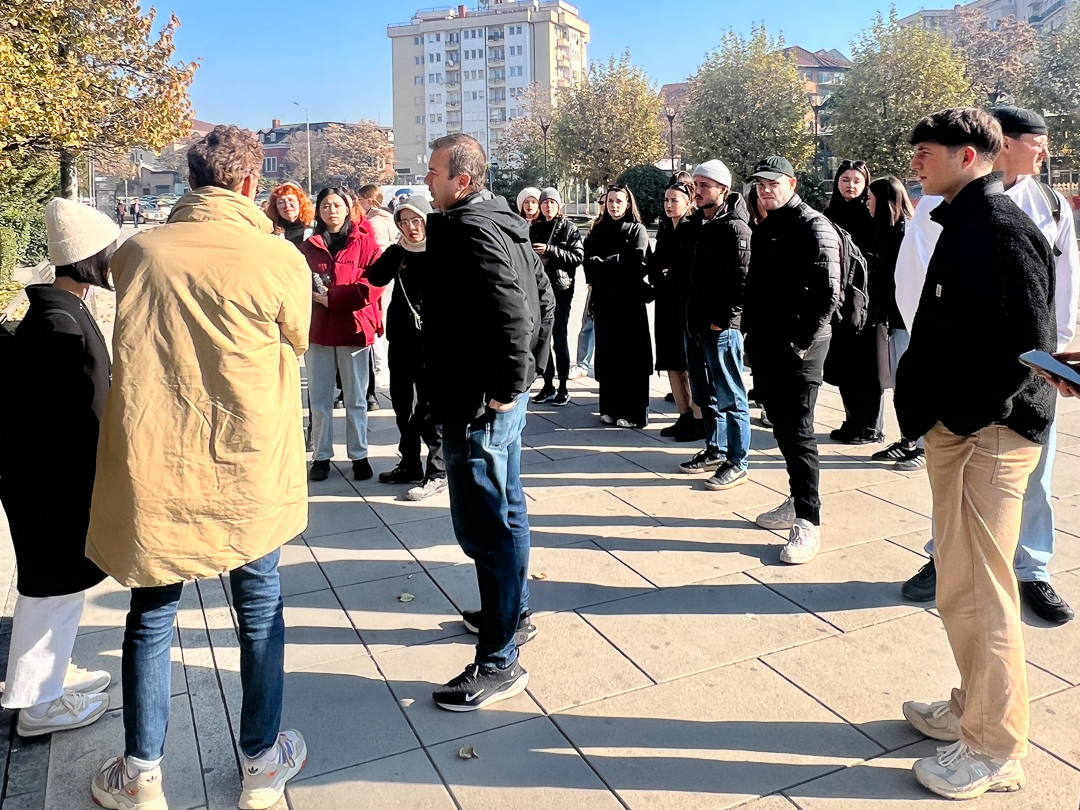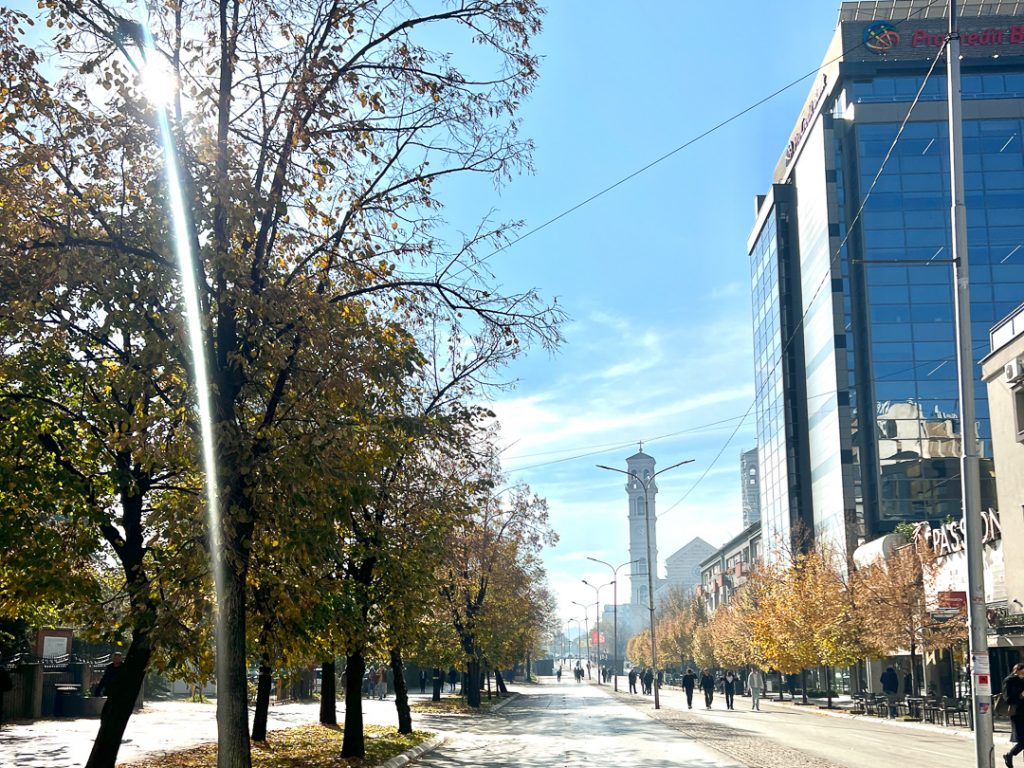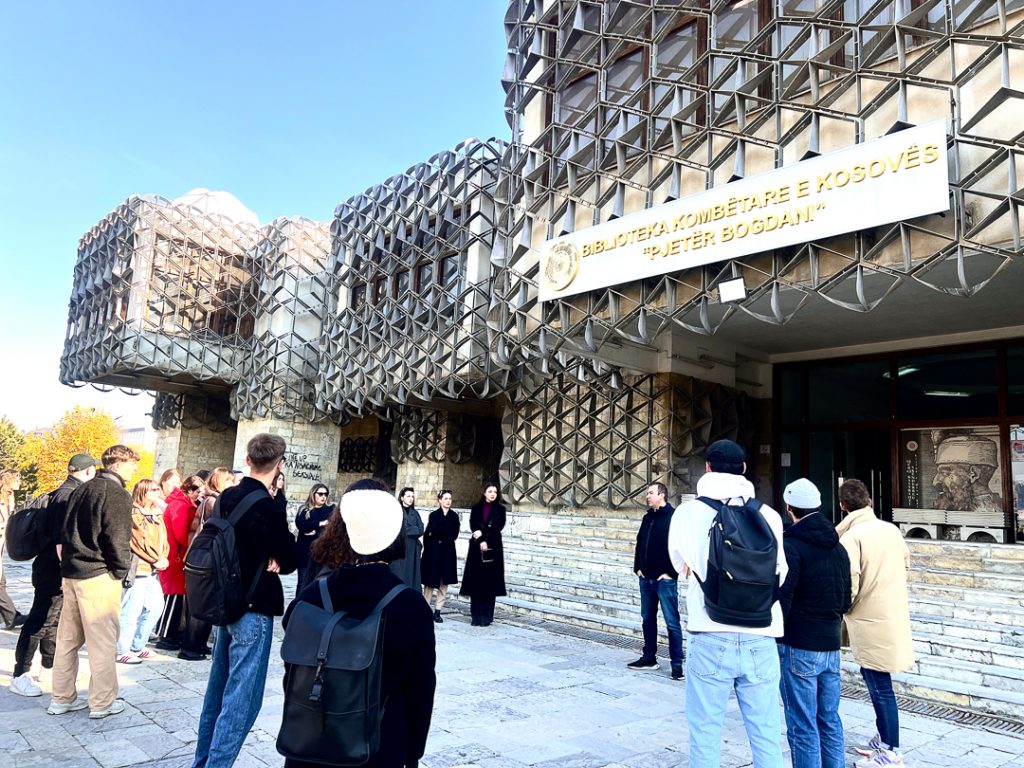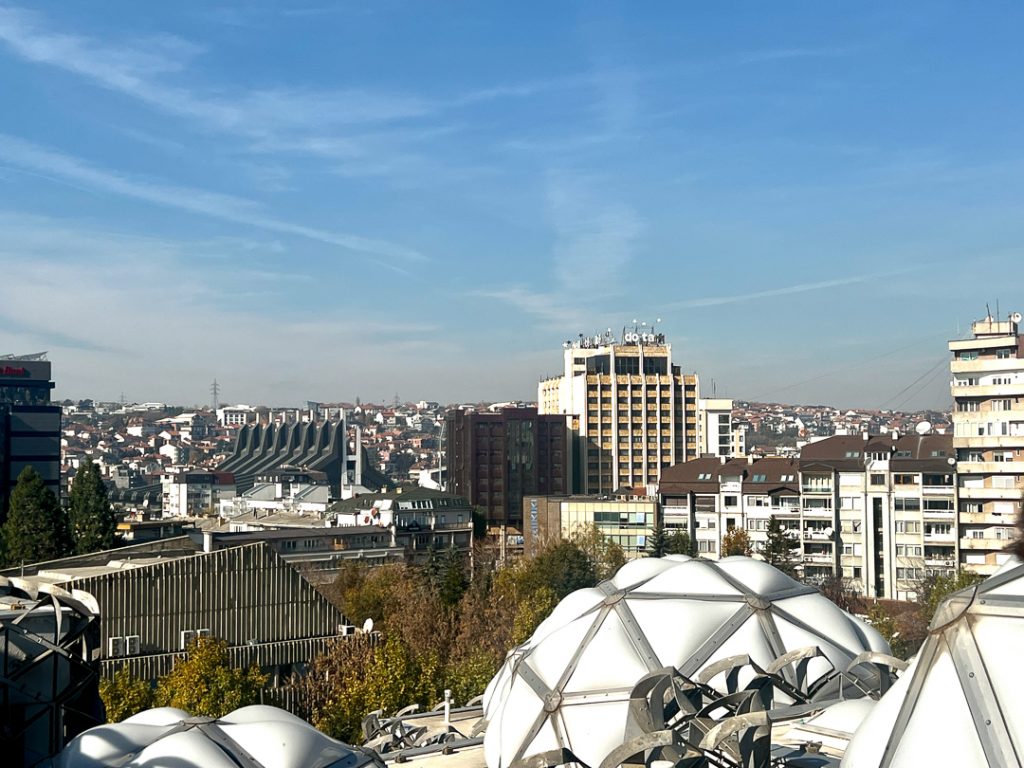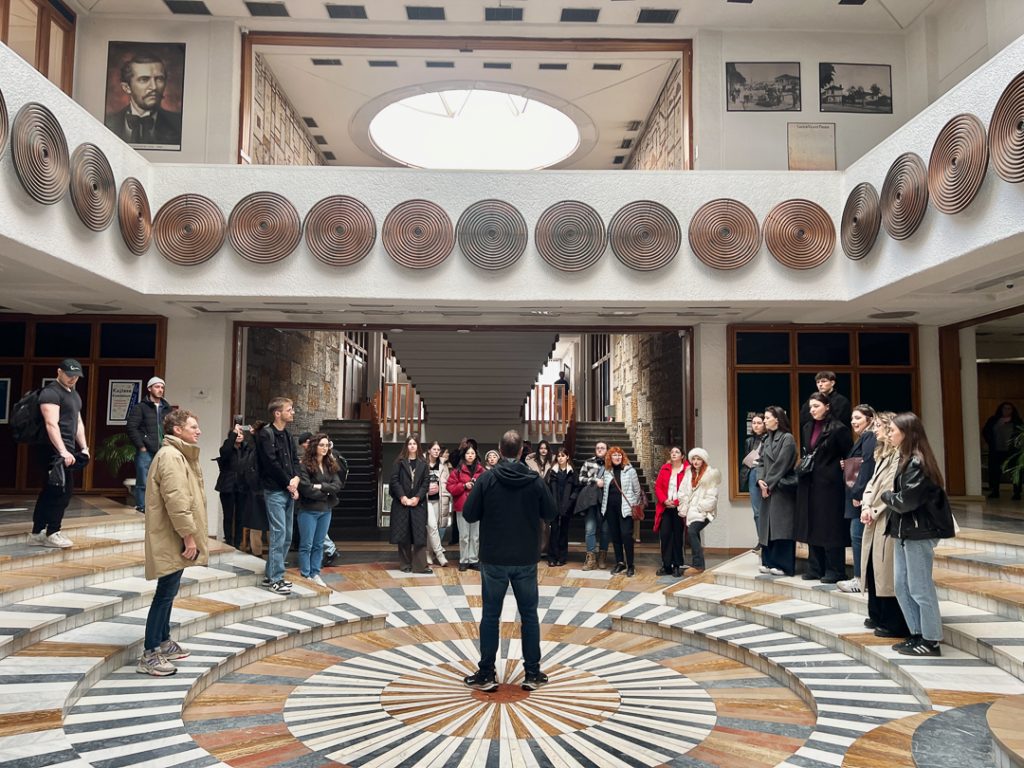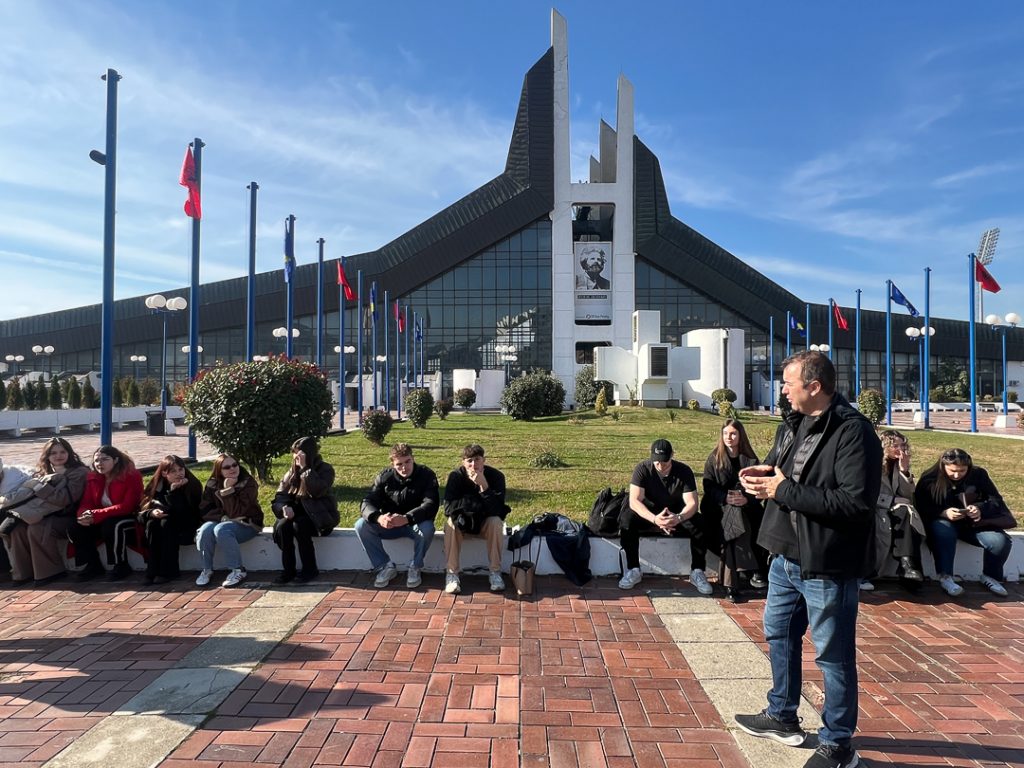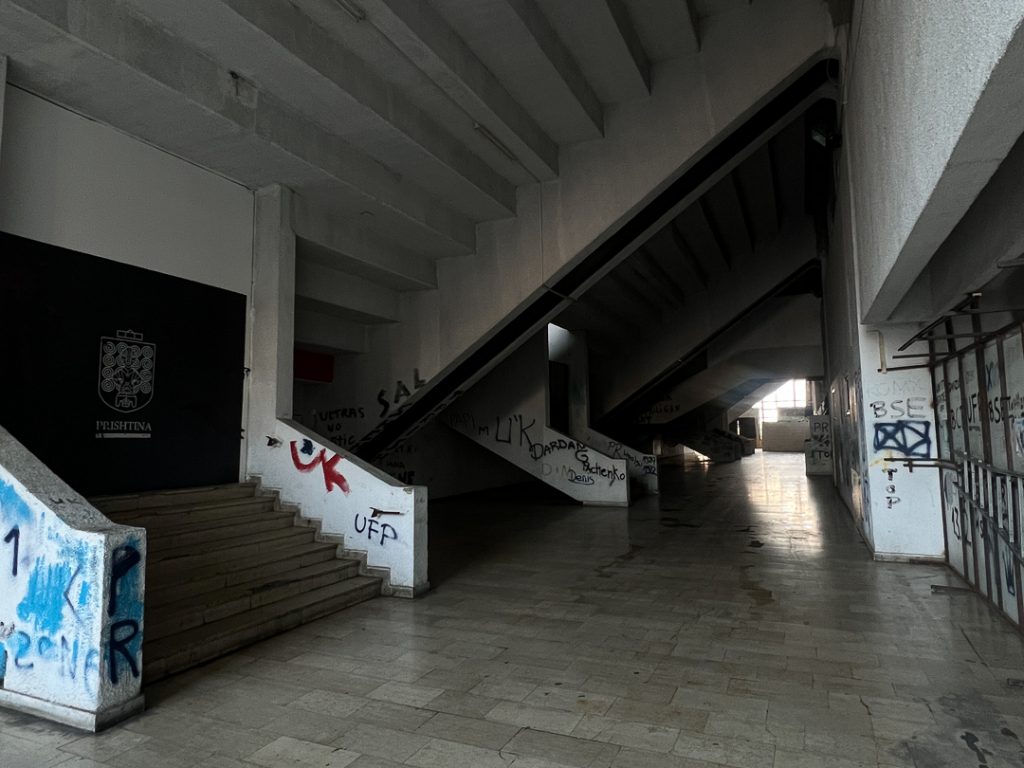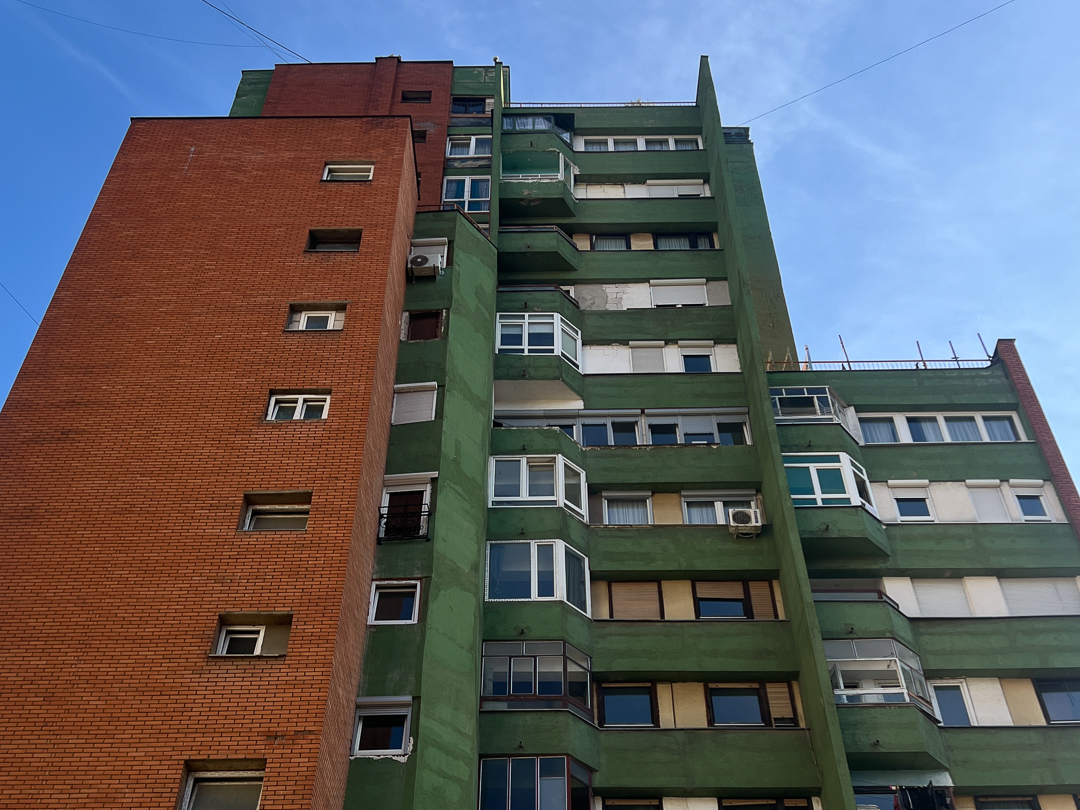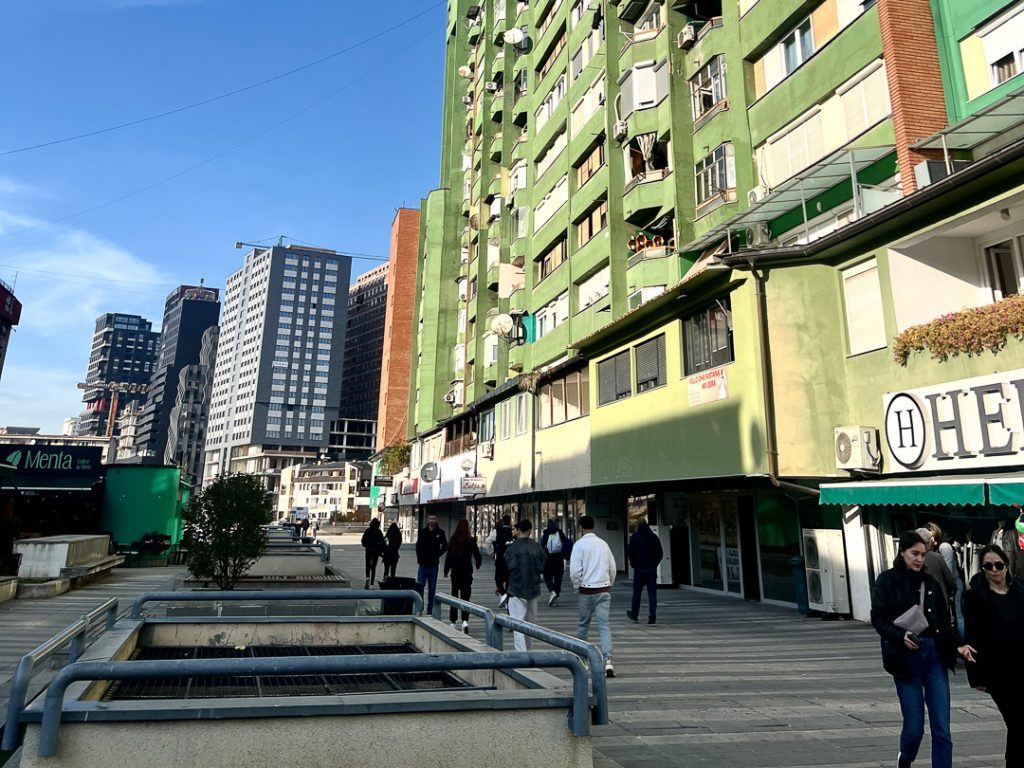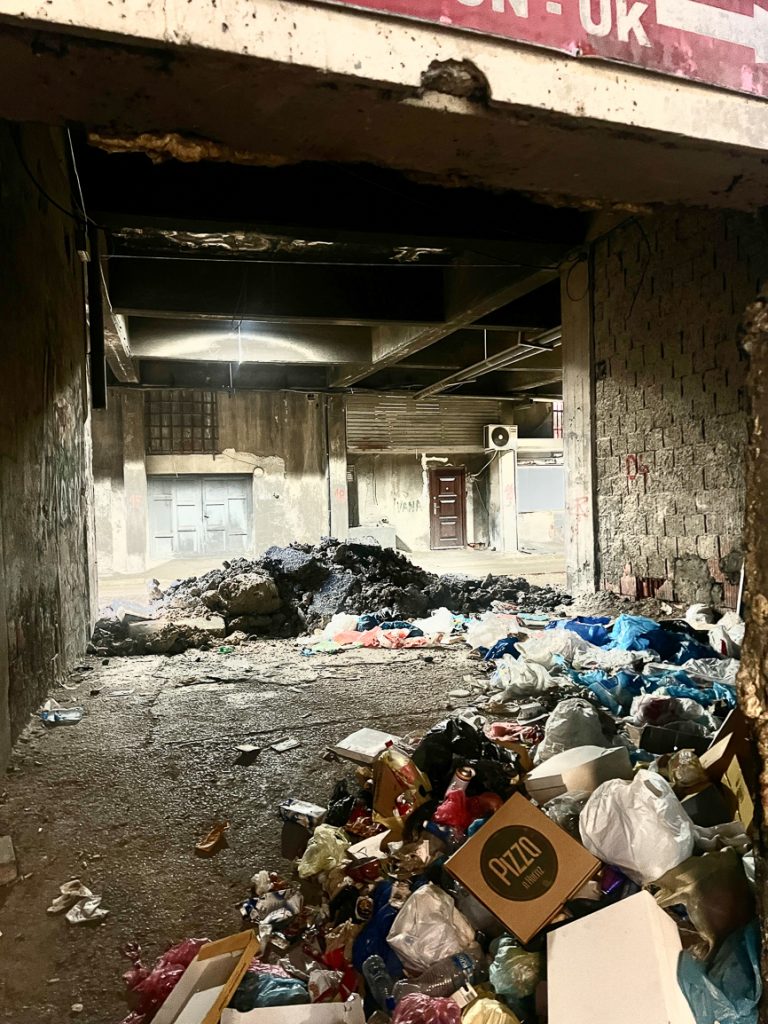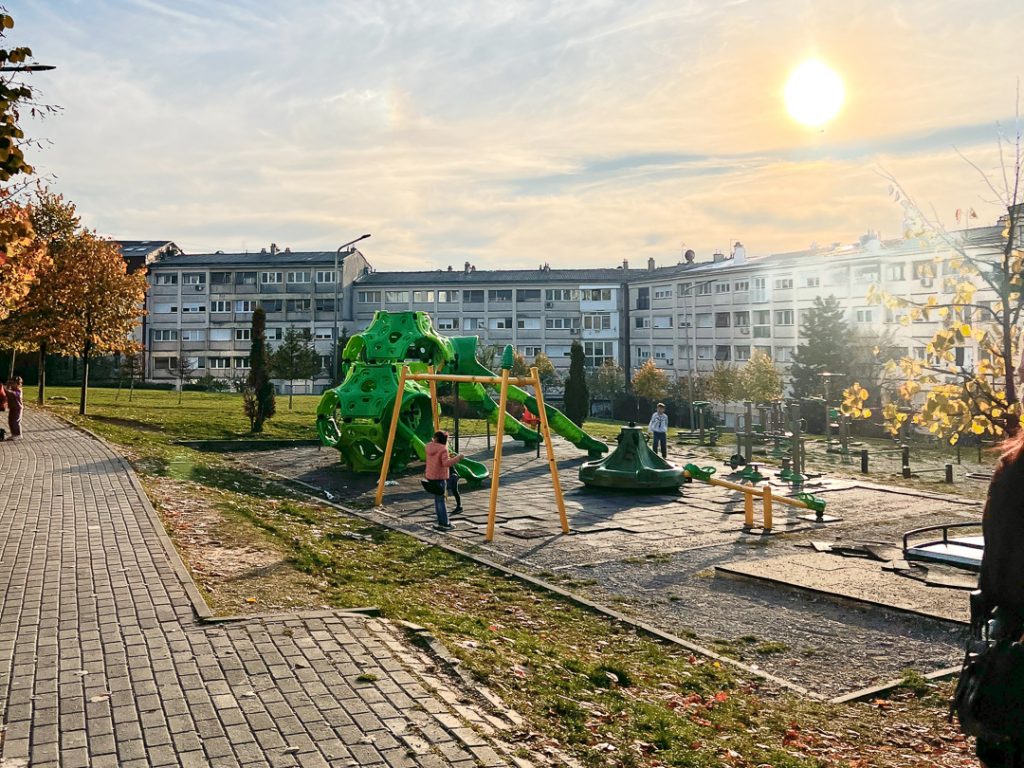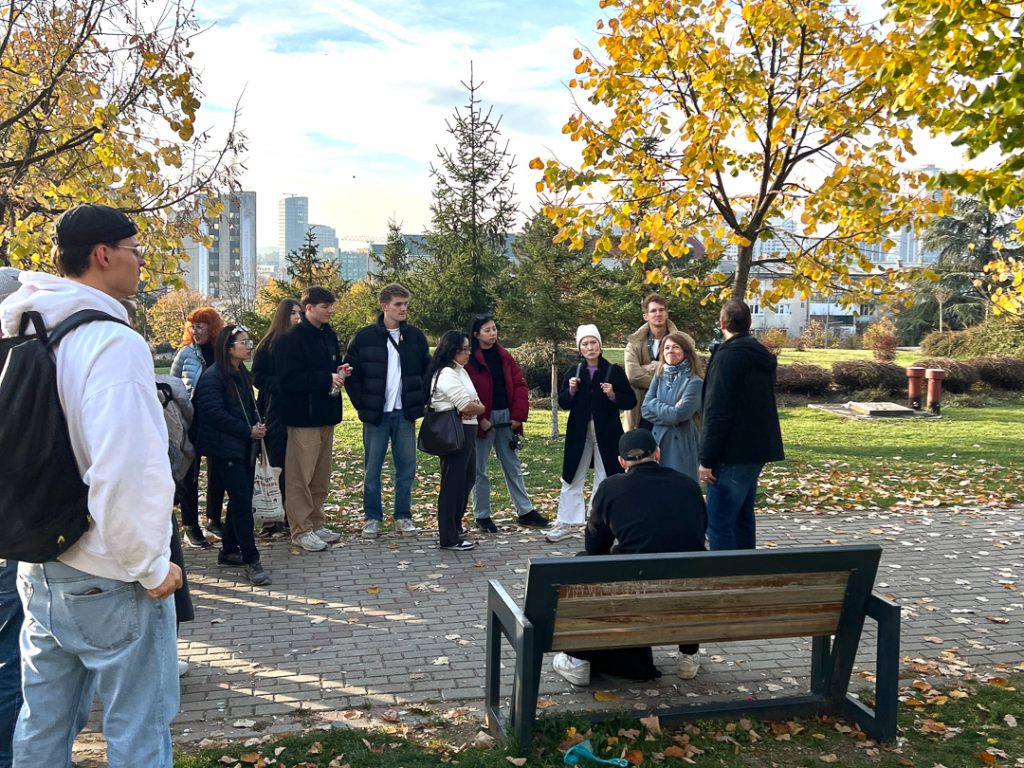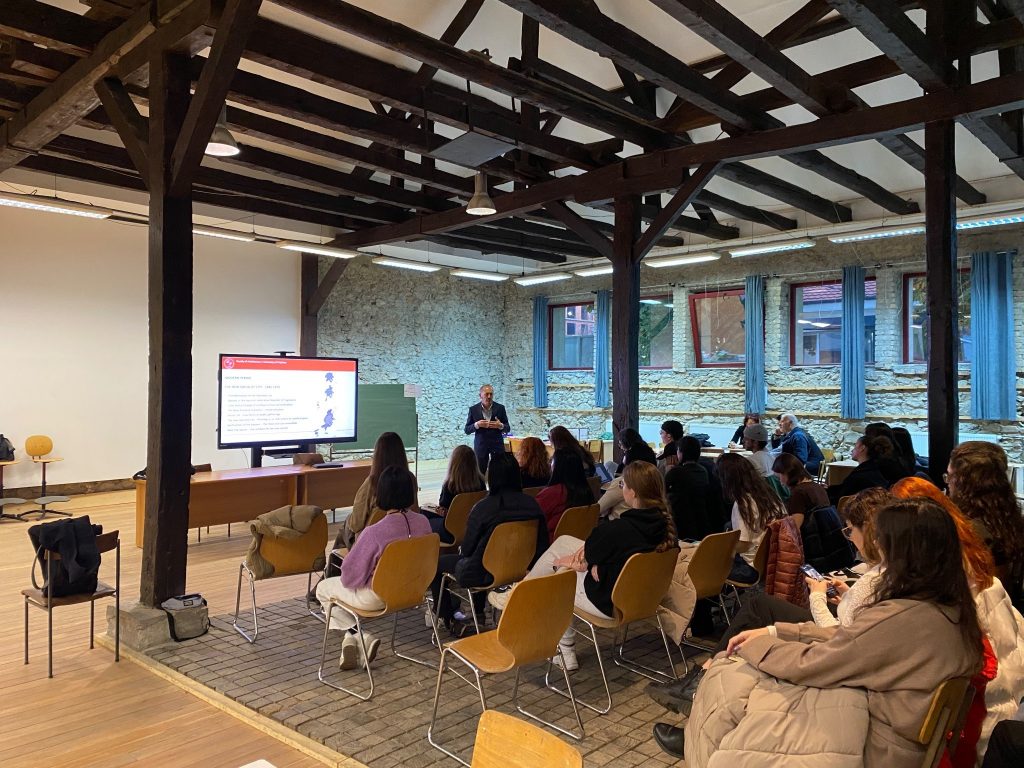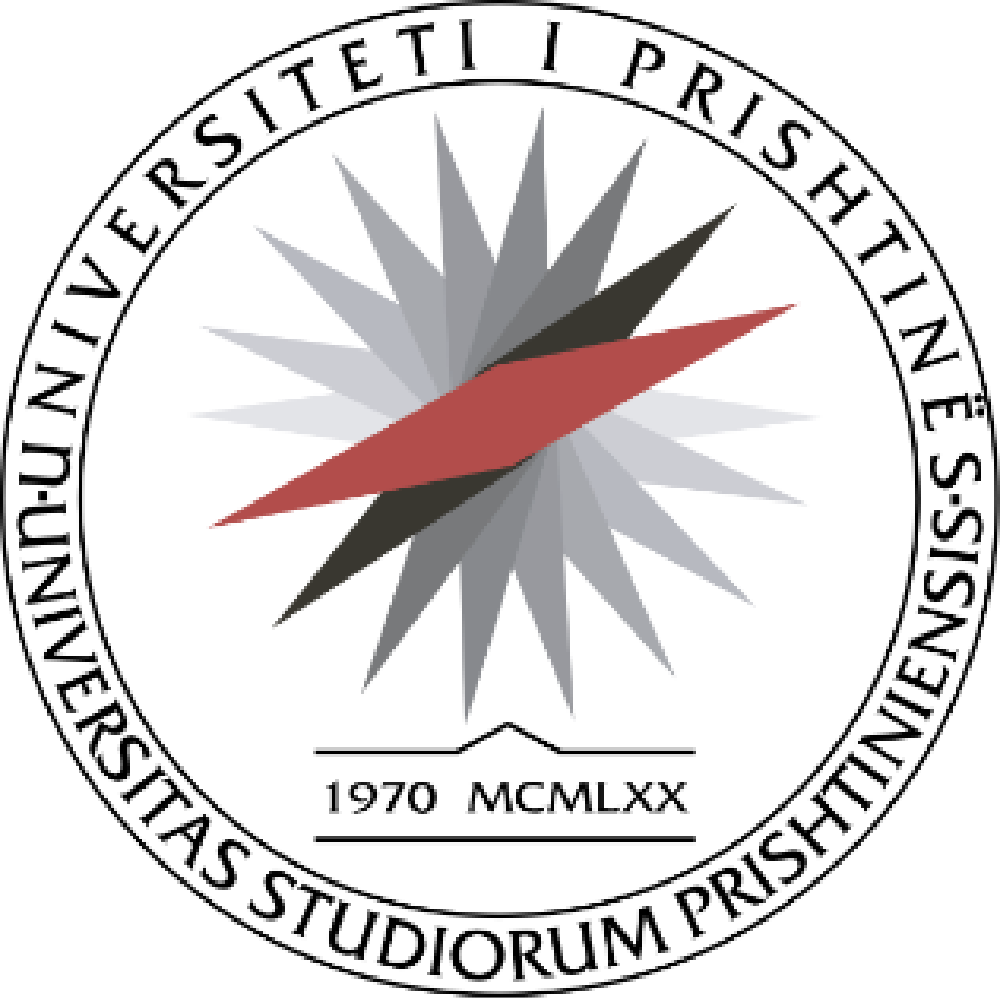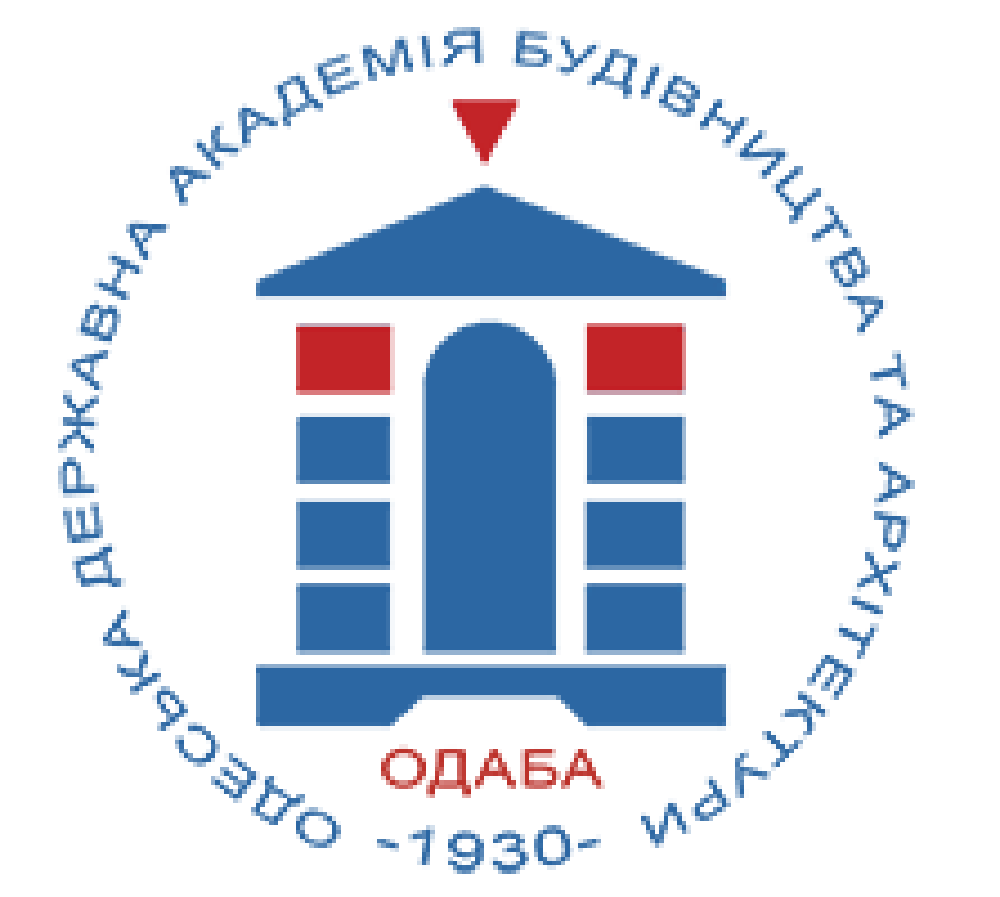A Warm Welcome to Prishtina: Exploring Kosovo’s Capital with Bekim Ramku
On the first day of our excursion through Prishtina, we, along with students from KIT, the University of Prishtina, and the Academy of Odessa, dived into the city’s vibrant atmosphere. Our guide, the renowned architect and head of the Kosovo Architecture Foundation, Bekim Ramku, led us through the city, offering fascinating insights into Prishtina’s architectural landscape and urban development.
First Impressions and Big Ideas: Dialogue on City Life and Urban Planning
Our tour of Prishtina was an inspiring exchange about urban development and the capital’s future. We started on “Adem Jashari” Square, in front of the “Vellazerim Bashkimi” Monument and then continued to "Boulevard Nënë Tereza" where Ramku explained the post-war construction boom in Prishtina and explained the efforts of architect Rexhep Luci- at that time also Director of the Spatial Planning Department of Prishtina, who was killed while on duty, to stop illegal construction. We then moved to "Xhorxh Bush" Street – a pedestrian zone that Bekim Ramku highly recommended. This pedestrian street is more than just a thoroughfare; it showcases how a city once dominated by car traffic can begin to create space for people. By day, the area fills with pedestrians, students, and families, all finding a welcome respite from the hustle of traffic. You can feel that the pedestrian-friendly design is a step toward a more human-centered Prishtina. For Bekim, this transformation is part of a significant shift that shows how architecture and urban planning can enrich the lives of citizens – a crucial step for a city with immense potential for sustainable development. The vibrant atmosphere of this boulevard sparks hope that Prishtina will soon have more such spaces that return the urban space to the people, fostering public life.
A Bold Statement or Misfit? Prishtina’s National Library
During our tour, we encountered one of the city’s most striking and controversial buildings: the National Library of Prishtina. Since its opening in 1982, the library’s architecture has sparked mixed opinions. With its bold mix of concrete, glass, and distinctive domes, it stands as a symbol of modern Prishtina – and likely leaves no one indifferent. Our guide, Bekim Ramku, shared interesting perspectives and explained that while the library is celebrated as a bold architectural milestone, it is often perceived as a "foreign" element in the cityscape.
The interior of the library offers spacious reading rooms and public areas that attract academic communities. Yet, there are challenges. Bekim mentioned that due to heating issues, space heaters are often necessary for students to use the facilities in winter
The tour ended on a high note with a unique opportunity. Thanks to our guide, Bekim Ramku, we were invited to enjoy a breathtaking view of Prishtina from the roof of the National Library. From this vantage point, we could appreciate the city from an entirely new perspective – offering a perfect conclusion to an insightful exploration of the building and its surroundings.
The Place of Youth and Sports – Between Vision and Reality
The Place of Youth and Sports in Prishtina is a notable architectural project that tells a story not only of ambitious plans for the future but also of unfulfilled promises. Our guide, Bekim Ramku, took us through the building, offering insights into its history and the challenges faced by the complex.
Particularly the sports hall, originally intended as the heart of the project, was never fully completed. Bekim explained that an explosion from a gas canister caused the hall's structure to collapse, and since then, the building has neither been renovated nor checked for potentiallypotential hazardous materials. For these reasons, no further construction work has been carried out.
The larger of the two halls once served a very special function, as Bekim shared with us: in winter, it was regularly flooded with water and turned into a public ice rink. Ramku explained the whole project and informed us how it was once intended to be built, with a large plato connecting the Palace of Youth and Sports with the Grand Hotel Despite the ongoing issues, local initiatives are trying to unlock the full potential of the building, aiming to revive the "Place of Youth" as a vibrant space for the people of Prishtina. As such, it remains a place with promising possibilities for the future.
Life Beyond the Landmarks: Prishtina’s Residential Landscape
In addition to iconic landmarks, informal residential areas also shape the urban landscape of Prishtina. Bekim, our guide, led us through one such housing complex, which is unique in many ways and tells interesting stories about the city. The block in the picture, one of the largest in the city, is characterized by its two-story construction and the innovative living solutions its residents created.
The most striking feature is the tunnel running through the lower level, which divides the block both visually and functionally. This architectural peculiarity gives the neighborhood its own distinct character.
In the 1990s, as Bekim told us, many of the apartments in this neighborhood were owned by state enterprises, which housed workers and employees, such as medical staff, there. At the time, the area had a rather grim reputation and was considered one of the most dangerous parts of the city. It was a place struggling with the challenges of transformation, a period when the entire region was grappling with change, uncertainty, and growth. These residential areas were initially part of socialist housing projects after World War II and were part of an ambitious, collectivist vision. Over the years, the architecture has mirrored Prishtina’s development and the many stories of the people who have lived in these buildings.
For many of us, this glimpse was fascinating and provided a different perspective on what "home" can mean for the residents of Prishtina – even beyond the shining facades of new apartment buildings. Bekim emphasized that, despite their often rough charm, such neighborhoods are deeply rooted in the city’s history and identity and play an essential role in Prishtina’s urban structure. Exploring these areas, you can feel how the past resonates in the present, and how Prishtina, as a city, preserves part of its identity in these unassuming but significant buildings.
A City in Search of Quality Green Spaces: A Model for Prishtina’s Future Parks
One of the central problems that has been affecting Prishtina for years is the lack of green spaces – a problem that particularly affects the daily lives of its residents. In a rapidly growing city, where buildings are crowding together, green space has become something of a rare luxury. Although there are regulations stating that at least 15–20% of every private property must remain green, in practice, these areas are often quickly converted into parking lots. This shortage of public recreational spaces is especially felt by the younger population who yearn for such places.
However, if you venture beyond the city center, you can discover small green parks in some renovated socialist-era residential neighborhoods. These parks are not only equipped with playgrounds, basketball, and football fields, but they also maintain generous green areas that invite people to relax. A surprising detail that our guide Bekim pointed out is the presence of old bunkers, relics from past times, that have been preserved within these public green spaces and contribute to the atmosphere of the parks.
It’s fascinating how such green spaces bridge the past and the present, becoming important places for retreat in today’s urban life. In a city that is constantly changing and growing, these parks serve as a quiet but significant anchor for community life – and a reminder of how valuable every square meter of green space is in Prishtina.
A Glimpse into Prishtina's Past and Present: From Ottoman Roots to Modern Metropolis
After the tour, the students had the opportunity to deepen their understanding of Prishtina’s urban development through a lecture by Dr. Techn Ilir Gjnolli. The presentation, titled “From Ottoman to Modern – The Transformation of Prishtina since 1945,” offered an in-depth look at the evolution of the city. Dr. Gjnolli’s talk, accompanied by an exhibition and a supporting book, brought the experiences of Prishtina’s citizens to life, showcasing the city’s journey from its Ottoman roots to its modern-day form.
Ottoman Foundations: The Heartbeat of Prishtina's Social Life
During the Ottoman era, Prishtina's urban landscape was defined by its bustling bazaars, the central marketplace that was not only the economic hub but also a social and cultural gathering spot. These marketplaces were where much of the city’s daily life took place, with mosques constructed by wealthy patrons and drinking fountains serving both spiritual and social purposes. The city's design during this period was shaped by the importance of these public spaces, with a focus on community engagement and cultural exchange.
From Conflict to Change: Prishtina’s Shifting Landscape (1912–1941)
The years from 1912 to 1941 were marked by intense transformation as Prishtina was affected by the Balkan Wars, a quest for independence, and various occupations. This period saw early industrialization and a shift in the city’s trade and finance structures, while migration began to alter its social fabric. With each political change, Prishtina’s identity evolved, preparing the city for a new era of development and growth.
Socialist Vision: The Rise of New Urban Ideals (1945–1970)
In the post-war period, Prishtina embraced the ideals of socialism, which were reflected in the construction of modern residential neighborhoods. These neighborhoods were designed to embody the principles of a new society, with private businesses limited to small establishments like cafés and food shops. Public monuments, like the Liberation Monument, served as symbols of the societal values of the time. The central Boulevard Nënë Tereza emerged as the city’s primary public space, a venue for shopping, socializing, and recreation, helping to shape the modern fabric of the city.
A Modern Vision: Prishtina's Growth into a City of the Future (1970–1990)
Between 1970 and 1990, Prishtina saw the expansion of its modern urban landscape as Kosovo’s political profile within Yugoslavia strengthened. This period saw the creation of new residential neighborhoods, including Ulpiana, the city’s first modern housing development designed for workers and small families. Equipped with schools, playgrounds, and sports fields, these areas reflected a growing emphasis on public services and amenities. Key landmarks such as the Grand Hotel symbolized the social and political progress of the time, helping to cement Prishtina’s place as a modern, vibrant city.
